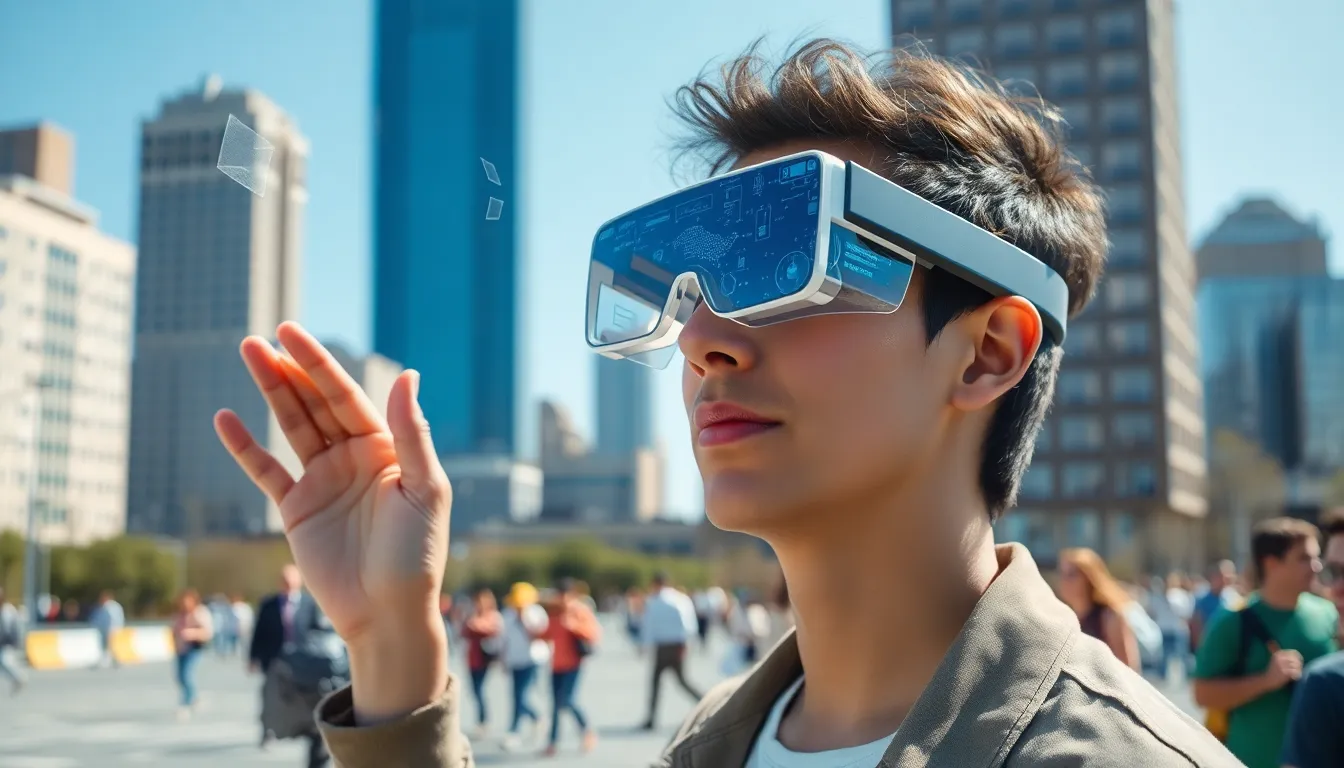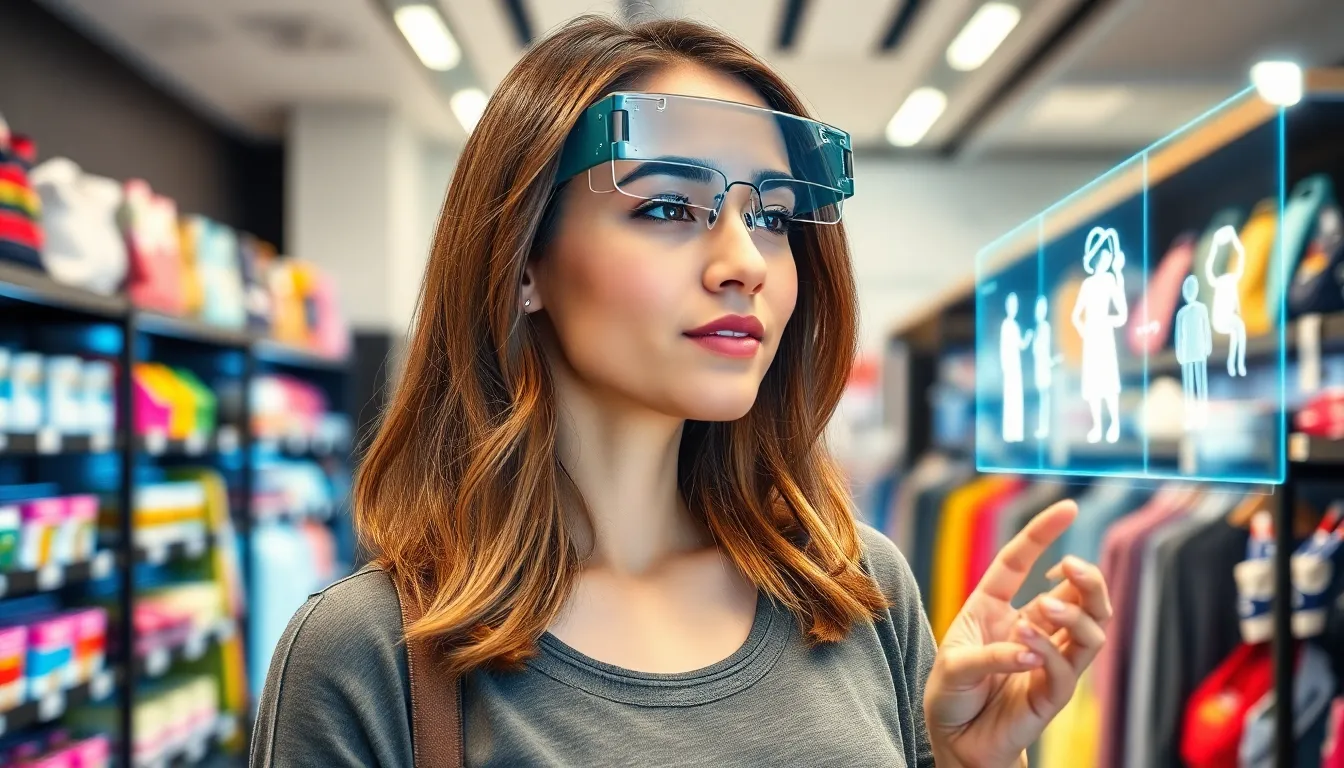In a world where technology blurs the lines between reality and imagination, augmented reality (AR) and virtual reality (VR) are the dynamic duo stealing the spotlight. Picture this: AR sprinkles digital magic over the real world, letting you check your email while dodging virtual flying pigs. Meanwhile, VR transports you to fantastical realms where you can battle dragons or sip coffee on Mars—all without leaving your couch.
As these immersive technologies evolve, they’re not just for gamers anymore. Businesses, educators, and even your grandma are getting in on the action. But which one reigns supreme? With AR enhancing reality and VR creating entirely new worlds, the debate heats up. Buckle up as we dive into the quirky yet fascinating clash of AR versus VR, exploring their unique strengths and wild potential.
Table of Contents
ToggleOverview of Augmented Reality and Virtual Reality
Augmented reality (AR) overlays digital information onto the real world, creating an interactive experience that enhances user perception. Digital elements merge seamlessly with the physical environment, allowing users to see graphics and text in real time. This technology finds applications in industries like retail, healthcare, and education, where it improves learning and customer engagement.
Virtual reality (VR) immerses users in entirely different environments through simulated experiences. Users wear headsets that block out the real world, engaging them in a 360-degree environment. Gaming remains a popular use case for VR, while training programs in various sectors utilize it to create safe, risk-free simulations.
AR focuses on enhancing reality rather than replacing it. Examples of AR include apps that allow users to visualize furniture in their homes or guide them through complex tasks with visual prompts. These applications improve productivity and decision-making processes significantly.
VR prioritizes total immersion, offering experiences like virtual tours of historical sites or realistic flight simulations. Users feel as if they are actually present within these environments, engaging with elements that respond to their actions. Companies increasingly adopt VR for employee training to enhance skill acquisition and retention.
While AR and VR share technological foundations, their core purposes diverge. Augmented reality complements everyday life by adding digital insights, whereas virtual reality transports users to entirely different realms. As these technologies evolve, they continue blending into various sectors, leading to innovative solutions across business and education landscapes.
Key Differences Between Augmented Reality and Virtual Reality

Augmented reality (AR) and virtual reality (VR) represent distinct technological experiences. Both create unique interactions, yet they do so in fundamentally different ways.
Definition and Concept
Augmented reality overlays digital elements onto the real world, enhancing the user’s perception of their environment. Users see the physical space they occupy while experiencing additional information or graphics. This blend of digital and physical worlds is utilized in applications such as navigation and retail. Virtual reality, in contrast, immerses users entirely in a computer-generated environment. Headsets or other gear block out the real world, transporting individuals into different realms altogether. Simulations found in the gaming industry exemplify this immersive approach. Each technology provides distinct experiences tailored to different contexts and needs.
User Experience and Interaction
User experience differs significantly between AR and VR. Engaging with AR involves interaction with both the digital overlays and the physical environment. Users can manipulate virtual items while remaining aware of their surroundings, allowing for seamless integration into daily activities. In contrast, VR offers a fully immersive experience where users engage solely with the virtual environment. Interaction relies on headsets and controllers, and users often lose awareness of their real surroundings. The choice between AR and VR thus depends on desired engagement level and context. Each experience shapes how users interact with technology and the real world.
Applications of Augmented Reality
Augmented reality (AR) finds diverse applications across various sectors, enhancing user experiences by integrating digital elements into the physical world.
Industries Utilizing Augmented Reality
Healthcare leverages AR for surgical planning and training simulations, providing visual overlays that enhance understanding. Retail stores use AR to allow customers to visualize products in their environments before purchasing, increasing buyer confidence. Education employs AR for interactive learning experiences that engage students, making complex subjects more tangible. Automotive industries enhance assembly lines with AR to assist workers with visual guides, improving accuracy in manufacturing processes. Real estate agents offer virtual tours of properties using AR, enabling potential buyers to explore homes remotely.
Benefits of Augmented Reality
Enhanced engagement arises from AR’s ability to provide interactive experiences that capture user interest. In retail, businesses see increased sales as customers can visualize products, leading to informed decisions. Training programs benefit from AR by providing realistic simulations without real-world risks, making it ideal for high-stakes environments like aviation. Cost savings emerge as remote assistance through AR reduces the need for on-site experts, allowing technicians to solve problems collaboratively. Overall, AR improves efficiency across tasks, streamlining workflows in various industries.
Applications of Virtual Reality
Virtual reality (VR) has various applications across multiple sectors, providing immersive experiences that enhance training and entertainment.
Industries Utilizing Virtual Reality
Education stands at the forefront of VR adoption, where immersive environments make learning more engaging. Healthcare benefits greatly from VR through surgical simulations, allowing medical professionals to practice procedures in a risk-free setting. The architecture and construction sectors utilize VR to visualize projects, helping clients make informed decisions before breaking ground. Entertainment has traditionally used VR for gaming experiences, but it’s now expanding into virtual concerts and film. Finally, real estate employs VR for virtual property tours, enabling potential buyers to explore homes from anywhere, making the process more accessible.
Benefits of Virtual Reality
Enhanced training experiences are a primary benefit of VR, allowing users to practice complex skills in a controlled environment. Realistic simulations reduce training costs and risks associated with traditional methods. Increased engagement occurs as users immerse themselves in unique scenarios, heightening interest and retention. Collaborative opportunities arise through shared virtual spaces, enabling teams to work together remotely. Improved customer experiences result from interactive demonstrations, allowing clients to visualize products in a virtual context before purchase decision. These advantages illustrate VR’s transformative potential across various industries.
Challenges and Limitations
Augmented reality and virtual reality face several challenges limiting their widespread adoption and effectiveness.
Technical Constraints
Technical constraints hinder AR and VR technologies from reaching their full potential. Hardware requirements for VR, such as high-performance headsets and powerful computers, create barriers for some users. AR often requires specific devices, like smartphones or smart glasses, which may not support advanced features. Additionally, bandwidth limitations might affect the seamless delivery of AR experiences, causing lag or disruptions. Content development remains a challenge as creating high-quality, interactive applications requires substantial time and resources. It’s essential for industry leaders to address these limitations for wider integration into everyday life.
User Adoption and Accessibility
User adoption remains a critical hurdle for both AR and VR technologies. Many people find the cost of equipment prohibitive, particularly for VR headsets and compatible devices. Accessibility can pose further issues, as some users may feel uncomfortable with immersive experiences or struggle with motion sickness. Moreover, a lack of awareness about the benefits and applications of AR and VR often results in hesitance to engage with these technologies. Educational initiatives and demonstrations can enhance understanding and encourage more active participation. Overcoming these barriers is vital for maximizing the reach of these innovative solutions.
Future Trends in Augmented Reality and Virtual Reality
AR and VR technologies are poised for substantial growth, transforming industries and user experiences. Businesses increasingly leverage AR for marketing, enhancing in-store experiences via digital overlays. Retailers utilize AR apps to allow customers to visualize products in their own homes, improving purchase decisions.
Healthcare applications for AR will expand, allowing surgeons to overlay critical information during procedures. Medical training programs benefit from VR simulations, providing students risk-free environments to practice skills. Education continues to embrace immersive VR experiences, facilitating deeper engagement through interactive lessons.
User interface improvements are on the horizon as developers striveto create more intuitive experiences. AR glasses are becoming lighter and more comfortable, promising broader adoption. Gamers can expect enhanced VR systems with better graphics and reduced latency, making gameplay more immersive.
Collaboration tools within VR are gaining traction, enabling teams to meet in virtual environments. Remote work environments integrate AR and VR, promoting team interaction regardless of geographic location. These technologies will also play a significant role in virtual tourism, offering realistic travel experiences from home.
The entertainment sector anticipates growth through VR experiences that go beyond gaming into live events and storytelling. Additionally, AR partnerships with social media platforms enhance user engagement through interactive filters and experiences. Industry leaders recognize that recognizing and overcoming barriers to adoption remains crucial for widespread usage.
While AR and VR technologies are evolving rapidly, ensuring accessibility and affordability are vital for their future. User education initiatives will facilitate understanding and encourage adoption. Continued advancements promise innovative applications across various fields, shaping the way individuals and businesses engage with the world around them.
The future of augmented reality and virtual reality is bright and full of potential. As these technologies continue to evolve they promise to transform various industries by enhancing user engagement and creating immersive experiences. Businesses educators and individuals are increasingly recognizing the value of AR and VR in improving workflows and providing innovative solutions.
Overcoming existing challenges like hardware limitations and user adoption will be critical in maximizing their impact. With ongoing advancements in technology and increased accessibility the possibilities for AR and VR are limitless. The journey of these technologies is just beginning and their integration into everyday life will only deepen in the years to come.






